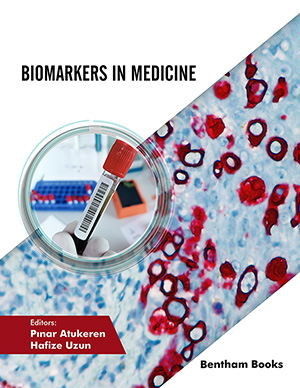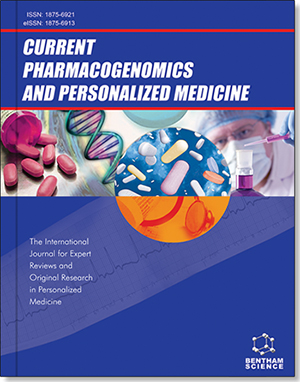New Biomarkers and Immunotherapy Decision
Page: 1-15 (15)
Author: Abdurrahman Yigit, Berkay Kuscu, Ali Kirik, Ruhsen Ozcaglayan and Cigdem Usul Afsar*
DOI: 10.2174/9789815040463122010003
PDF Price: $30
Abstract
As immune checkpoint blockade and other immune-based therapy approaches lead to broad treatment advances among patients with advanced cancer, an important consideration is how to best select patients whose tumors will respond to these therapies. As a consequence predictive and prognostic markers are needed. There are genomic features, such as tumour mutation burden (TMB), microsatellite instability (MSI), and immune phenotype features, such as programmed death-ligand 1 (PD-L1), CTLA-4 and tumour infiltrating lymphocytes (TILs), to predict response to immunotherapies (ITs). Several studies show the correlation between TMB and predicted neoantigen load across multiple cancer types. Response to immune checkpoint inhibitors is higher in tumours with high TMB. The candidate biomarker that has been studied mostly other than TMB is PD-L1 expression in trials utilizing programmed cell death-1 (PD-1) blockade. PD-L1 and PD-1 expression are dynamic markers that change in relation to local cytokines and other factors, and the thresholds that separate “positive” and “negative” PD-L1 expressions remain under debate. PD-L1 expression is now a routine diagnostic marker for patients with newly diagnosed NSCLC. The potential applicability of PD-L1 in other disease settings is still uncertain. Microsatellite instability is characterised by high rates of alterations to repetitive DNA sequences caused by impaired mismatch repair (MMR); MSI was the biomarker was approved according to tumor's initial location. Combining TMB with specific genomic alterations is crucial. Moreover, new biomarkers are being investigated.
Biomarkers in Gynecologic Tumors
Page: 16-36 (21)
Author: Selim Afsar*
DOI: 10.2174/9789815040463122010004
PDF Price: $30
Abstract
Gynecologic malignancies are one of the most frequent cancers amongst women. Biomarkers are crucial for the differential diagnosis of adnexal masses; however, their potential for diagnosis is limited. In the era of difficulty in ovarian cancer screening, novel biomarkers are defined, but CA125 still remains the most valuable one. Circulating tumor DNAs, DNA hypermethylation, metabolites, microRNAs, and kallikreins have recently turned out as ovarian cancer biomarkers and are being applied to clinical practice. For uterine cancer, genomic classification has now been described, it will be used as a prognostic tool. In this chapter, we describe ovarian, endometrial, and cervical cancer biomarkers in detail.
Biomarkers in Urological Cancers
Page: 37-76 (40)
Author: Bulent Onal*, Mehmet Hamza Gultekin, Muhammed Fatih Simsekoglu, Berin Selcuk and Ahmet Gurbuz
DOI: 10.2174/9789815040463122010005
PDF Price: $30
Abstract
Urological tumours have become one of the most common cancers in the last decade. It is important to apply an approach that evaluates many factors related to the patient and the disease carefully to minimize cancer-associated morbidity and mortality. The clinical use of cancer biomarkers is a valuable part of the clinical management of urological cancers. These biomarkers may lead to optimized detection, treatment, and follow-up of urological cancers. With the development of molecular research, newly developed biomarkers and next-generation sequencing have also contributed to patient management. In this chapter, we will present biomarkers in the most common urological cancers under subheadings of bladder cancer, prostate cancer, kidney cancer, and testicular cancer. Additionally, due to the development that occurred in the next-generation sequencing (NGS), all the above-mentioned malignancies are evaluated with regard to NGS.
Circulating Biomarkers in Thyroid Cancer
Page: 77-94 (18)
Author: Lebriz Uslu-Beşli*
DOI: 10.2174/9789815040463122010006
PDF Price: $30
Abstract
Thyroid cancer is the most important endocrine cancer with increasing incidence. While thyroid cancers, especially papillary thyroid cancers, are known to exhibit generally a favorable outcome with excellent survival rates, some thyroid cancers are more aggressive with a poor prognosis. Several different biomarkers have been introduced for the diagnosis of disease, identification of tumor load, assessment of therapy response, and the detection of recurrence during follow-up of the thyroid cancer patients. This chapter gives a brief overview of the circulating biomarkers used in thyroid cancer patients.
DNA Methylation Biomarkers in Cancer: Current Clinical Utility and Future Perspectives
Page: 95-112 (18)
Author: Sinem Durmus*, Remise Gelisgen and Hafize Uzun
DOI: 10.2174/9789815040463122010007
PDF Price: $30
Abstract
Epigenetic alterations are related to inherited but reversible changes in modifications that regulate gene activity beyond the DNA sequence. DNA methylation is the best characterized epigenetic modification, controlling DNA stability, DNA structure, transcription, and regulation, contributing to normal development and differentiation. In this section, we first discuss the cellular functions of DNA methylation and focus on how this fundamental biological process is impaired in cancer. Changes in DNA methylation status in cancer have been heralded as promising targets for the development of diagnostic, prognostic, and predictive biomarkers due to their noninvasive accessibility in bodily fluids (such as blood, urine, stool), reversibility, stability, and frequency. The absence of markers for definitive diagnosis of most types of cancer and, in some cases, DNA methylation biomarkers being more specific and sensitive than commonly used protein biomarkers indicate a strong need for continued research to expand DNA methylation markers. Although the information on changes in DNA methylation status in cancer and research on its clinical relevance is rapidly increasing, the number of DNA methylation biomarkers currently available as commercial tests is very small. Here, we focus on the importance of DNA methylation location and target genes likely to be developed in the future for the development of biomarkers in addition to existing commercial tests. Following a detailed study of possible target genes, we summarize the current clinical application status of the most studied and validated DNA methylation biomarkers, including SEPT9, SDC2, BMP3, NDRG4, SFRP2, TFPI2, VIM and MGMT.
Circulating Biomarkers in Predicting Pathological Response to Neoadjuvant Therapy for Colorectal Cancer
Page: 113-132 (20)
Author: Ravindri Jayasinghe, Umesh Jayarajah* and Sanjeewa Seneviratne
DOI: 10.2174/9789815040463122010008
PDF Price: $30
Abstract
Circulating biomarkers show promise in the management of many cancers. They have become the novel non-invasive approach to complement the current strategies in colorectal cancer (CRC) management. Their ability in guiding diagnosis, evaluating response to treatment, screening and prognosis is phenomenal, especially when it comes to their minimally invasive nature. These “liquid biopsies,” which show potential for replacing invasive surgical biopsies, provide useful information on the primary and metastatic disease by providing an insight into cancer biology. Analysis of blood and body fluids for circulating tumour DNA (ctDNA), carcinoembryonic antigen (CEA), circulating tumour cells (CTC), or circulating micro RNA (miRNA) shows potential for improving CRC management. Recognizing a predictive model to assess response to neoadjuvant chemotherapy would help in better patient selection. This review was conducted with the aim of outlining the use of circulatory biomarkers in current practice and their effectiveness in the management of patients having CRC with a focus on response to neoadjuvant therapy.
Circulating Biomarkers in the Management of Breast Cancer
Page: 133-149 (17)
Author: Ravindri Jayasinghe, Umesh Jayarajah* and Sanjeewa Seneviratne
DOI: 10.2174/9789815040463122010009
PDF Price: $30
Abstract
Circulating biomarkers have become a promising modality in the management of many cancers. Similarly, in breast cancer, circulatory biomarkers are useful, non-invasive methods in the diagnosis, prognostication, and evaluation of response to treatment. Invasive surgical biopsies can be potentially replaced by “liquid biopsy,” which involves analysing circulatory biomarkers that may reveal features of primary and metastatic disease. Therefore, providing an insight into the cancer biology can be utilised to monitor treatment response, treatment-induced adaptation and tumour and disease progression through non-invasive means. The objective of this review is to provide an overview of the current status of the circulating biomarkers highlighting their promising impact on the management of patients with breast cancer.
Clinical Application of Biomarkers for Hematologic Malignancies
Page: 150-212 (63)
Author: Nurgül Özgür Yurttaş and Ahmet Emre Eşkazan*
DOI: 10.2174/9789815040463122010010
PDF Price: $30
Abstract
Over the last decade, significant advancements have been made in the molecular mechanisms, diagnostic methods, prognostication, and treatment options in hematologic malignancies. As the treatment landscape continues to expand, personalized treatment is much more important.
With the development of new technologies, more sensitive evaluation of residual disease using flow cytometry and next generation sequencing is possible nowadays. Although some conventional biomarkers preserve their significance, novel potential biomarkers accurately detect the mutational landscape of different cancers, and also, serve as prognostic and predictive biomarkers, which can be used in evaluating therapy responses and relapses. It is likely that we will be able to offer a more targeted and risk-adapted therapeutic approach to patients with hematologic malignancies guided by these potential biomarkers. This chapter summarizes the biomarkers used (or proposed to be used) in the diagnosis and/or monitoring of hematologic neoplasms.
Applications of Biomarkers in Cancer Surgery
Page: 213-237 (25)
Author: Berrin Papila Kundaktepe*
DOI: 10.2174/9789815040463122010011
PDF Price: $30
Abstract
The most problematic and difficult cases of general surgery applications are cancers. Cancer can be diagnosed in many ways, including the presence of some symptoms and signs, screening tests, and imaging methods. The diagnosis of cancer is confirmed anatomically by microscopic examination of tissue samples. Biomarker research has become increasingly interesting for many medical fields today. Biomarkers are indicators of the biological process that can show changes in disease and health status and reveal pathological conditions. The sensitivity of markers used for early and painless diagnosis is weak in all types of cancer, including thyroid, breast, stomach, pancreatic, and colorectal cancers. Biochemical and molecular markers have been found to be of great importance in cancer research in recent years in the formation mechanisms and treatment steps of cancer. Several biomarkers have been studied in the circulating body fluids and tissue of preoperative, intraoperative, and postoperative patients. The main use of tumor markers is the follow-up of the response to treatment and early detection of recurrences in patients diagnosed with cancer. Tumor markers correctly selected will guide the patient's monitoring and treatment planning. But, still, the field of cancer surgery needs new biomarkers.
A Pathophysiological Approach To Current Biomarkers
Page: 238-275 (38)
Author: Aykut Oruc* and Gonul Simsek
DOI: 10.2174/9789815040463122010012
PDF Price: $30
Abstract
Biomarkers are necessary for screening and diagnosing numerous diseases, predicting the prognosis of patients, and following-up treatment and the course of the patient. Everyday new biomarkers are being used in clinics for these purposes. This section will discuss the physiological roles of the various current biomarkers in a healthy person and the pathophysiological mechanisms underlying the release of these biomarkers. This chapter aims to gain a new perspective for evaluating and interpreting the most current biomarkers.
Biomarkers in Otorhinolaryngology
Page: 276-308 (33)
Author: Ayse Pelin Yigider* and Ozgur Yigit
DOI: 10.2174/9789815040463122010013
PDF Price: $30
Abstract
Biomarkers of otorhinolaryngologic diseases with higher insult over a person’s him/herself and overall health services are summarized in brief. In order to define, diagnose, treat and monitor any disease markers are needed. Otorhinolaryngology (ORL) is interested in special disease entities of the region besides otorhinolaryngologic involvements of the systemic diseases and unique forms of pathologies such as cholesteatoma, Meniere’s disease and otosclerosis. Neoplasia is another heading to deal with. In the following chapter, one will find an overview of molecules that have been used as a biomarker as well as the end points of the present research on the issue relevant with ORL. Day by day, new molecules are being named however, the pathways of action are rather the same. Readers will find the headings related to the most common diseases of the field, informing them about where to look for defining new strategies of understanding of each disease.
Pharmacogenomic Biomarkers
Page: 309-377 (69)
Author: Zeynep Gizem Todurga Seven*, Deniz Özen and Sibel Özyazgan
DOI: 10.2174/9789815040463122010014
PDF Price: $30
Abstract
Why does the usual dose of medication work for a person while another individual cannot give the expected response to the same drug? On the other hand, how come half of the usual dose of an analgesic relieves an individual’s pain immediately, as another man continue to suffer even after taking double dose? Although a treatment method has been successfully used in majority of the population for many years, why does the same therapy cause serious side effects in another region of the world? Most presently approved therapies are not effective in all patients. For example, 20-40% of patients with depression respond poorly or not at all to antidepressant drug therapy. Many patients are resistant to the effects of antiasthmatics and antiulcer drugs or drug treatment of hyperlipidemia and many other diseases. The reason for all those is basically interindividual differences in genomic structures of people, which are explained in this chapter in terms of the systems and the most frequently used drugs in clinical treatment.
Clinical Application of Circulating MicroRNAs as Novel Biomarkers for Different Diseases
Page: 378-406 (29)
Author: Volkan Sozer, Pınar Atukeren and Hafize Uzun*
DOI: 10.2174/9789815040463122010015
PDF Price: $30
Abstract
Biomarker research has become increasingly interesting in many areas nowadays. Biomarkers are indicators of the biological process that can show changes in disease and health status and reveal pathological conditions. There is always a need for markers that divide patients into risk categories that can help in early diagnosis, detect complications ahead of time, guide treatment, and predict adverse outcomes in a chronic complex and certain diseases such as cancer. microRNAs (miRNAs) are ~ 22 nt long npcRNAs involved in post-transcriptional arrangements. miRNAs regulate messenger RNAs (mRNA), especially through negative regulation of gene expression. The fact that miRNAs have come to the fore in many disease mechanisms brings up their use as biomarkers in the early stage. The purpose of this review is to gather the latest information on this subject by bringing together recent articles and reviews to contribute to understanding the role of miRNAs, which act as biomarkers in different ways in vital processes, in the formation, early diagnosis, and treatment of diseases. miRNAs have an important potential to become a next-generation biomarker and therapeutic. But, each miRNA molecule can bind to a large number of different mRNAs, and different miRNAs in each mRNA. Therefore, new findings are needed to determine the expression activities and targets of miRNAs.
Advancements in Gastrointestinal System Biomarkers
Page: 407-424 (18)
Author: Suleyman Demiryas* and Anıl Orhan
DOI: 10.2174/9789815040463122010016
PDF Price: $30
Abstract
The requirement for diagnostic surgical operations of gastrointestinal system diseases significantly decreases with the help of proper diagnostic tools. These modalities are also beneficial for identifying postoperative complications, allowing us to diagnose them in earlier stages, and increasing the postoperative survival rates. Biomarkers are considered an integral part of diagnostic examinations. Developments of biomarkers used for diagnosing and treating abdominal diseases are essential for improving our capabilities in non-invasive monitoring. In this chapter, we review both the novel and the routine biomarkers in the diagnosis and follow-up of gastrointestinal system diseases.
Novel Applications of Biomarkers in Chronic Obstructive Pulmonary Disease
Page: 425-439 (15)
Author: Pelin Uysal*
DOI: 10.2174/9789815040463122010017
PDF Price: $30
Abstract
Chronic obstructive pulmonary disease (COPD) is an important health problem and an increasing cause of morbidity and mortality worldwide. Currently, COPD is considered a multisystem disease. Although it primarily affects the lungs, structural and functional changes occur in other organs due to systemic inflammation. It is stated that in patients with COPD, airway and systemic inflammatory markers are increased and that these markers are high are associated with a faster decline in lung functions. In recent years, numerous articles have been published on the discovery and evaluation of biomarkers in COPD. Many markers have also been studied to accurately assess COPD exacerbations and provide effective treatment. However, based on the evidence from published studies, a single molecule has not been adequately validated for broad clinical use.
Biomarkers in Diabetes Mellitus
Page: 440-449 (10)
Author: Fatih Orkun Kundaktepe*
DOI: 10.2174/9789815040463122010018
PDF Price: $30
Abstract
Diabetes mellitus (DM) is a chronic metabolic disease characterized by hyperglycemia that occurs as a result of impaired insulin secretion and/or insulin effect, or both of these factors. The fact that the disease has both individual and social dimensions makes it important to detect as early as possible and make the necessary lifestyle changes. For this purpose, it becomes necessary to develop fast, effortless, cheap, and reliable methods for diagnosis. We discussed which biochemical markers should enter routine use according to their sensitivity and specificity among the biochemical markers that have been used and are still being studied. In this chapter, we explored some methods that may be used as biomarkers and discussed advantages and pitfalls for each.
Biomarkers and their Clinical Applications in Pediatrics
Page: 450-489 (40)
Author: Yusuf Elgormus*
DOI: 10.2174/9789815040463122010019
PDF Price: $30
Abstract
Biomarker studies are becoming increasingly interesting for many fields of medicine. The use of biomarkers in medicine is involved in detecting diseases and supporting diagnosis and treatment decisions. New research and new discoveries on the molecular basis of the disease show that there may be a number of promising new biomarkers for use in daily clinical practice. Clinical trials in children lag behind adult research both in quality and quantity. The number of biomarkers validated to optimize pediatric patient management is limited. In the pathogenesis of many diseases, it should not be extrapolated to the pediatric clinical setting, taking into account that biomarkers that are effective in adults are clearly different in children and that ontogeny directly affects disease development and therapeutic response in children. The search for ideal biomarkers or markers that can make an early and definitive diagnosis in neonatal sepsis is still ongoing. The ideal biomarker for pediatric diseases should be costeffective, noninvasive, applicable to pediatric specific diseases, and its results should correspond to age-related physiological changes. Lactate, troponin and B-type natriuretic peptide are valuable biomarkers in the evaluation and management of critically ill children with cardiac disease. Tumor markers in children are biochemical substances used in the clinical treatment of pediatric tumors and to detect the presence of cancer (regression or progression). In this chapter, current and brief information about biomarkers and their clinical applications used in the diagnosis and monitoring of pediatric diseases is presented.
Biomarkers in Liver Disease
Page: 490-521 (32)
Author: Abdullah Sonsuz* and Oguz Kagan Bakkaloglu
DOI: 10.2174/9789815040463122010020
PDF Price: $30
Abstract
Symptoms and signs of liver diseases are highly variable depending on the etiology, disease stage, and type of liver involvement. There are different types of liver diseases; causes of liver diseases may be viral, toxic, metabolic, or autoimmune. However, in some cases, liver disease can develop as a result of diseases of other organs or systems. It is almost impossible to differentiate all of these solely on the basis of clinical symptoms and findings. Furthermore, the early stages of liver disease may be completely asymptomatic, or in some cases, the disease may progress with only subtle and non-specific symptoms. Therefore, biomarkers have a critical role in screening, diagnosis, staging, and evaluation of therapeutic response to treatment in liver diseases.
Application of New Acute Kidney Injury Biomarkers
Page: 522-543 (22)
Author: Nurhan Seyahi* and Seyda Gul Ozcan
DOI: 10.2174/9789815040463122010021
PDF Price: $30
Abstract
Kidney-related biomarkers can provide structural and functional information about different parts of the nephron. These biomarkers can be used to evaluate glomerular, tubular, or interstitial injury, inflammation, or repair, and glomerular or tubular function. Furthermore, biomarkers can improve the acute kidney injury diagnosis in various clinical conditions, including acute interstitial nephritis, acute tubular injury, hepatorenal and cardiorenal syndrome, ischemic and nephrotoxic acute kidney injury, and drug-induced acute kidney injury. Biomarkers might be used as an additional precision medicine tool in managing patients with acute kidney injury; they can help with clinical decision-making and impact patient outcomes. In this chapter, we reviewed the utility of biomarkers used in acute kidney injury.
Biomarkers to Predict Sudden Cardiac Death
Page: 544-554 (11)
Author: Ali Uğur Soysal* and Kivanc Yalin
DOI: 10.2174/9789815040463122010022
PDF Price: $30
Abstract
Sudden cardiac death (SCD) is a common disorder and an unsolved issue for health care providers. Despite several risk factors for SCD, some cases experience SCD as an initial presentation of cardiovascular disease. Prediction of individuals at increased risk for SCD is important for implementing community-based approaches and individual-based therapies with high costs, such as implantable defibrillators. This chapter discusses the potential role of biomarkers in predicting SCD in different cardiovascular diseases.
Oxidative Stress Biomarkers in the Diagnosis and Prognosis
Page: 555-564 (10)
Author: Pınar Atukeren*
DOI: 10.2174/9789815040463122010023
PDF Price: $30
Abstract
Oxidative stress describes the state of a cell where there is an imbalance between free radical formation and antioxidants due to either excess formation of reactive oxygen species (ROS) or inadequate antioxidant defence. It is very well known that oxidative stress plays an important role in the pathophysiology of various diseases through impaired intracellular redox homeostasis. To evaluate and imply the excess production of ROS, various biomarkers are used and suggested, yet it is also known that there is a lack of standardization and validation for these methods. It is almost very difficult to measure ROS directly because of their short half-life, yet it is still possible with a suitable technique. The most frequently used biomarkers are represented by oxidized macromolecules such as lipids, proteins, and nucleic acids, which are modified via ROS, and also the amounts or activities of antioxidant molecules and enzymes, respectively. There are also various genetic biomarkers measuring the susceptibility of modification due to oxidative stress. However, the preferred biomarker would be dependent on the aim of the study and the clinical relevance.
Current Biomarkers for Endometrial Receptivity
Page: 565-580 (16)
Author: Ozlem Erten*, Aysun Tekeli Taskomur and Mustafa Albayrak
DOI: 10.2174/9789815040463122010024
PDF Price: $30
Abstract
Implantation and the continuation of pregnancy occur through a complicated and sophisticated dialogue, called “cross-talk,” which starts between the embryo and the endometrium in the early stages of oocyte maturation. This dialogue provides synchronization of the journey of the embryo to be implanted with the receptive endometrium. Understanding the activity and function of the hormones and factors involved in this dialogue will provide an understanding of endometrial receptivity, which plays a key role in implantation, and the determination of biomarkers specific for this period. As a result of the development of omics technology, it has become possible to identify biomarkers specific to endometrial receptivity by performing genomic, proteomic, and lipidomic analyses of these hormones and factors. The determination of these biomarkers, their optimization, and making them usable in the clinic will allow increased success in ART.
Biomarkers for Preterm Delivery
Page: 581-599 (19)
Author: Ismail BIYIK* and Mustafa ALBAYRAK
DOI: 10.2174/9789815040463122010025
PDF Price: $30
Abstract
Preterm birth occurring before the thirty-seventh gestational week complicates 4.5%-18% of pregnancies worldwide. The pathogenesis of spontaneous preterm delivery is not fully understood. Among the factors held to be responsible for its pathogenesis, the most emphasized is the inflammatory process. Studies in terms of the prediction of preterm delivery are basically divided into 3 categories: 1) Prediction in pregnant women who are asymptomatic and without risk factors, 2) Prediction in pregnant women who are asymptomatic and have risk factors, 3) Prediction in symptomatic pregnant women who have threatened preterm labour. In this chapter, the topic of biomarkers in relation to preterm delivery is discussed. The most commonly used markers in published studies are fetal fibronectin, cervical pIGFBP-1 and cervical length measurement by transvaginal ultrasound. For prediction in symptomatic pregnant women applying to the hospital with threatened preterm labour, the markers used are fetal fibronection, insulin-like growth factors (IGFs) and inflammatory markers. Preterm labour prediction with markers checked in the first and second trimesters are fetal fibronection, insulin-like growth factors (IGFs), micro RNAs, progesterone, circulating microparticles (CMPs), inflammatory markers, matrix metalloproteinases, aneuploidy syndrome screening test parameters and other hormones.
Biomarkers in Obesity and Clinical Applications to Surgical Practice: From Pharmacogenomics to Surgigenomics
Page: 600-610 (11)
Author: Halit Eren Taskin*
DOI: 10.2174/9789815040463122010026
PDF Price: $30
Abstract
Personalized medicine is an evolving field and helps in detecting putative targets for pharmacological treatment modalities in obesity treatment. Obesity has become a pandemic and major threat, increasing all causes of mortality and bringing a heavy cost burden on health budgets. Although bariatric/metabolic surgery justified its role as the most effective treatment regimen for obesity and related comorbidities in the long-term, some patients require revisional operations, do not respond to this treatment option, or experience a relapse of their co-morbidities. For this reason, detection of possible non-responders and prediction of patients at high risk for developing cardiovascular or metabolic adverse events in long-term follow-up is of utmost importance. Therefore, the individualization of surgical treatment by the use of novel biomarkers has come into prominence recently. Many biomarkers and gene loci had been identified related to adiposity, insulin resistance, and oxidative stress. In this brief chapter, the recent advances and clinical implications of these biomarkers will be elaborated.
Clinical Application of New Possible Biomarkers in the Assessment and Monitoring of Nutritional Status
Page: 611-625 (15)
Author: Burcu Yesilkaya*
DOI: 10.2174/9789815040463122010027
PDF Price: $30
Abstract
Nutrition is directly related to human health. It is very critical to determine the nutritional status to prevent or diagnose diseases and create the right treatment plans. The determination of the nutritional status provides an early diagnosis of growth and development retardation such as malnutrition. It also plays a major role in preventing diseases that may be caused by vitamin and mineral deficiencies. It helps in the surveillance of one of the world's most serious health problems, namely “obesity.” Different ways can be used to assess nutritional status. One of the best ways to assess the nutritional and health status is to use biomarkers. A biomarker is a substance whose detection indicates a specific disease state or a response to a therapeutic intervention. Biomarkers are used to detect nutrient consumption and deficiencies as early as possible, enabling early intervention for metabolic problems. Biomarkers also allow the visualization of diseases that a person might develop or potentially have with a sample, such as blood, tissue, and urine, from the person. Health interventions such as nutritional advice will preserve health or promote rapid recovery. In this chapter, the topic of biomarkers related to nutrition and nutrient deficiencies is discussed. The existence of new possible biomarkers is also reviewed.
A Physiological Approach to Inflammatory Markers in Obesity
Page: 626-654 (29)
Author: Sila H. Bozdogan Polat* and Nuran Dariyerli
DOI: 10.2174/9789815040463122010028
PDF Price: $30
Abstract
Obesity is one of the most critical health problems all over the world; it is associated with metabolic dysfunction and overnutrition. Changes in the physiological function of adipose tissue, leading to altered secretion of adipocytokines, inflammatory mediators release, and chronic low-grade inflammation, are seen in obesity. Macrophages, neutrophils, CD4+ and CD8+ T cells, B cells, natural killer T (NKT) cells, eosinophils, mast cells, and adipocytes are involved in the inflammatory response that occurs during obesity. Various inflammatory markers are released from these cells. In this chapter, we will mention inflammatory mechanisms and markers of obesity.
Application of Biomarkers in the Diagnostic Distinction of Bacterial and Viral Infections
Page: 655-678 (24)
Author: Fatma Köksal Çakırlar*
DOI: 10.2174/9789815040463122010029
PDF Price: $30
Abstract
Infectious diseases, which pose a great threat worldwide, have a significant impact on public health and the world economy. It contributes to increased healthcare costs, unnecessary drug-related side effects, and increased antimicrobial resistance. It is not always easy to distinguish the etiological differentiation of diseases that can develop with bacteria and viruses. Therefore, one of the biggest challenges in medicine is how to correctly distinguish between the different causes of these infections and how to manage the patient. Because bacterial and viral infections often present similar symptoms. The real decision is whether the infection is caused by bacteria or viruses and whether to treat the patient with antibiotics. There are many different methodological approaches to diagnosing infections. Biomarkers have been used in the diagnosis of diseases and other conditions for many years. Biomarkers are molecules found in blood and body fluids in measurable amounts, which can evaluate biological and pathological processes. These key indicators can provide vital information in determining disease prognosis, predicting response to treatments, adverse events and drug interactions, and identifying key risks. An effective biomarker is extremely important for the early diagnosis of various diseases. The explosion of interest in biomarker research is driving the development of new predictive, diagnostic, and prognostic products in modern medical practice. The purpose of this review is to demonstrate the use and diagnostic potential of current and investigational biomarkers in the distinction between bacterial and viral infections.
Subject Index
Page: 679-712 (34)
Author: Pınar Atukeren and Hafize Uzun
DOI: 10.2174/9789815040463122010030
Introduction
Biomarkers in Medicine is a comprehensive guide to understanding the current and future status of biomarkers. The book features 27 chapters focusing on disease biomarkers for diseases such as cancer, neurodegenerative diseases, cardiac diseases, metabolic conditions and much more. This book supplies readers with the unique insight of experts in multiple specialties in medicine and life sciences who have extensive experience in diagnostics and clinical laboratories. The book includes case studies and practical examples from different classes of biomarkers on different platforms, including new data for biomarkers in different therapeutic indications. In addition to presenting biomarker information, each chapter covers the relevant pathology and also emphasizes on preclinical and clinical manifestation of the disease process. Clinicians managing patients or clinical trials, clinical researchers, clinical laboratories, diagnostic companies, regulatory agencies, medical school graduate students, academic students, and the general public involved in healthcare delivery will all benefit from information presented in this book.





















